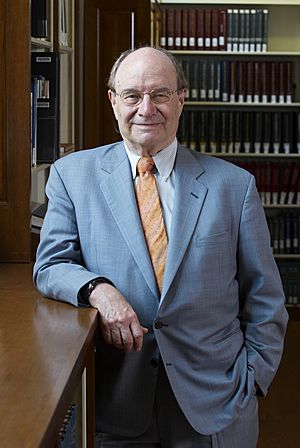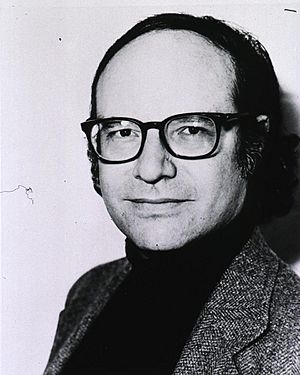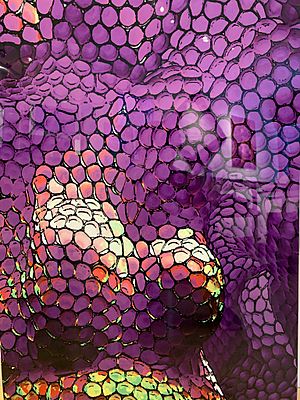Walter Gilbert facts for kids
Quick facts for kids
Walter Gilbert
ForMemRS
|
|
|---|---|

Walter Gilbert in 2008
|
|
| Born | March 21, 1932 Boston, Massachusetts, U.S.
|
| Education | |
| Known for | DNA sequencing |
| Spouse(s) |
Celia Stone
(m. 1953) |
| Children | 2 |
| Awards |
|
| Scientific career | |
| Fields | |
| Institutions | Harvard University |
| Thesis | On generalised dispersion relations and meson-nucleon scattering (1958) |
| Doctoral advisor | Abdus Salam |
| Doctoral students |
|
Walter Gilbert is a famous American scientist. He was born on March 21, 1932. He is known for his work in biochemistry and physics. He also helped start the field of molecular biology. He even won a Nobel Prize!
Contents
Early Life and Education
Walter Gilbert was born in Boston, Massachusetts, on March 21, 1932. His mother, Emma, was a child psychologist. His father, Richard, was an economist.
When Walter was seven, his family moved to the Washington D.C. area. His father worked for the government during a time called the New Deal. Walter met Celia Stone when they were both eight years old. They later married when they were 21.
Walter went to Harvard University for his college studies. He earned a bachelor's degree in chemistry and physics in 1953. He then got a master's degree in physics in 1954. He continued his studies at the University of Cambridge in England. There, he earned his PhD in physics in 1957. His teacher was Abdus Salam, who also won a Nobel Prize.
Scientific Career and Discoveries
Walter Gilbert returned to Harvard University in 1956. He became a physics professor in 1959. His wife, Celia, worked with James Watson, a famous scientist. This made Gilbert interested in molecular biology. Watson and Gilbert worked together in their lab for many years.
Gilbert helped start two important biotech companies. One was called Biogen, and the other was Myriad Genetics. He was the first chairman for both companies. He even left Harvard for a while to lead Biogen as its CEO.
Understanding DNA
Gilbert was one of the first scientists to suggest mapping the entire human genome. The human genome is like a complete instruction book for building a human. In 1986, he said that finding the full human sequence was a major goal. He believed that understanding the human genome would change biology. It would make computer databases as important as lab tools.
Key Discoveries
With his student Benno Müller-Hill, Gilbert was the first to clean and study the lac repressor. This is a special protein that controls genes. It was a big step in understanding how genes work.
Gilbert also worked with Allan Maxam to create a new way to read DNA sequences. This method used chemicals to figure out the order of DNA building blocks. This was a very important tool for scientists.
He also helped explain introns and exons. These are parts of genes. Introns are sections that are cut out, and exons are the parts that are used. He also suggested the RNA world hypothesis. This idea helps explain how life might have started on Earth. It suggests that RNA, a molecule similar to DNA, played a key role.
Awards and Recognition
Walter Gilbert has received many awards for his scientific work. In 1969, he won Harvard's Ledlie Prize. He was named an American Cancer Society Professor in 1972.
In 1979, he received the Louisa Gross Horwitz Prize. He also won the Gairdner Prize and the Albert Lasker Award that year.
Nobel Prize in Chemistry
Gilbert was awarded the 1980 Nobel Prize in Chemistry. He shared this prize with Frederick Sanger and Paul Berg. Gilbert and Sanger were honored for their groundbreaking work. They developed methods to figure out the order of nucleotides in nucleic acids, like DNA. This was a huge step forward in understanding life.
He was also recognized by the United States National Academy of Sciences in 1968. In 1987, he became a Foreign Member of the Royal Society. In 2002, he received the Biotechnology Heritage Award.
In 2017, a paper he wrote with Allan Maxam in 1977 was honored. It received a Citation for Chemical Breakthrough Award. This award recognized their new method for sequencing DNA.
Personal Life
Walter Gilbert married Celia Stone in 1953. They have two children. After he retired from Harvard in 2001, Gilbert started a new path. He began an artistic career. He combines art and science, focusing on digital photography.
See also
 In Spanish: Walter Gilbert para niños
In Spanish: Walter Gilbert para niños
- List of Jewish Nobel laureates



